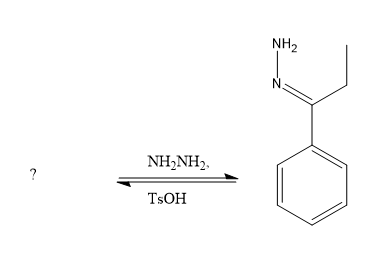Draw the starting reactant that would produce this mydrazone when treated with this reagent. Ignore inorganic byproducts. Drawing NH2NH2, TSOH NH₂ N
Draw the starting reactant that would produce this mydrazone when treated with this reagent. Ignore inorganic byproducts. Drawing NH2NH2, TSOH NH₂ N
Chemistry
10th Edition
ISBN:9781305957404
Author:Steven S. Zumdahl, Susan A. Zumdahl, Donald J. DeCoste
Publisher:Steven S. Zumdahl, Susan A. Zumdahl, Donald J. DeCoste
Chapter1: Chemical Foundations
Section: Chapter Questions
Problem 1RQ: Define and explain the differences between the following terms. a. law and theory b. theory and...
Related questions
Question
#11 help

Transcribed Image Text:**Chemical Reaction Synthesis Task**
**Objective:** Identify and draw the starting reactant needed to produce the given hydrazone when treated with the specified reagent. Inorganic byproducts should be ignored.
**Provided Reagent:**
- Hydrazine (NH₂NH₂) in the presence of para-toluenesulfonic acid (TsOH).
**Target Product:**
- A hydrazone compound, which includes a benzene ring connected to an ethyl group with an attached NH=N group (hydrazone functionality).
**Reaction Overview:**
The task involves the formation of a hydrazone through a reaction typically with an aldehyde or ketone. The expected starting material would be an aldehyde or ketone with a structure that, when reacted with hydrazine, forms the given hydrazone.
**Illustration Explanation:**
- The diagram at the bottom shows the chemical structure of the hydrazone product.
- The benzene ring is shown with alternating double bonds, and it is bonded to an ethyl group terminating with an NH=N group.
When identifying the starting reactant:
- Consider aldehydes or ketones that could react under these conditions to form the specific hydrazone shown.
**Note for Students:** While choosing the starting material, think about the carbonyl compounds that typically form hydrazones in reactions with hydrazine and acid catalysts.
Expert Solution
Step 1: Determine the starting reactant that would produce given product:
Given,
The reaction:

Step by step
Solved in 4 steps with 4 images

Knowledge Booster
Learn more about
Need a deep-dive on the concept behind this application? Look no further. Learn more about this topic, chemistry and related others by exploring similar questions and additional content below.Recommended textbooks for you

Chemistry
Chemistry
ISBN:
9781305957404
Author:
Steven S. Zumdahl, Susan A. Zumdahl, Donald J. DeCoste
Publisher:
Cengage Learning

Chemistry
Chemistry
ISBN:
9781259911156
Author:
Raymond Chang Dr., Jason Overby Professor
Publisher:
McGraw-Hill Education

Principles of Instrumental Analysis
Chemistry
ISBN:
9781305577213
Author:
Douglas A. Skoog, F. James Holler, Stanley R. Crouch
Publisher:
Cengage Learning

Chemistry
Chemistry
ISBN:
9781305957404
Author:
Steven S. Zumdahl, Susan A. Zumdahl, Donald J. DeCoste
Publisher:
Cengage Learning

Chemistry
Chemistry
ISBN:
9781259911156
Author:
Raymond Chang Dr., Jason Overby Professor
Publisher:
McGraw-Hill Education

Principles of Instrumental Analysis
Chemistry
ISBN:
9781305577213
Author:
Douglas A. Skoog, F. James Holler, Stanley R. Crouch
Publisher:
Cengage Learning

Organic Chemistry
Chemistry
ISBN:
9780078021558
Author:
Janice Gorzynski Smith Dr.
Publisher:
McGraw-Hill Education

Chemistry: Principles and Reactions
Chemistry
ISBN:
9781305079373
Author:
William L. Masterton, Cecile N. Hurley
Publisher:
Cengage Learning

Elementary Principles of Chemical Processes, Bind…
Chemistry
ISBN:
9781118431221
Author:
Richard M. Felder, Ronald W. Rousseau, Lisa G. Bullard
Publisher:
WILEY